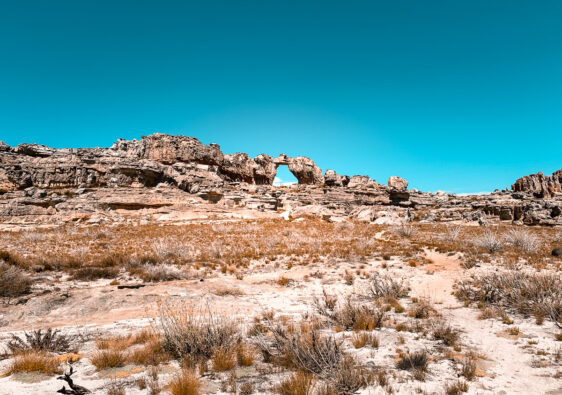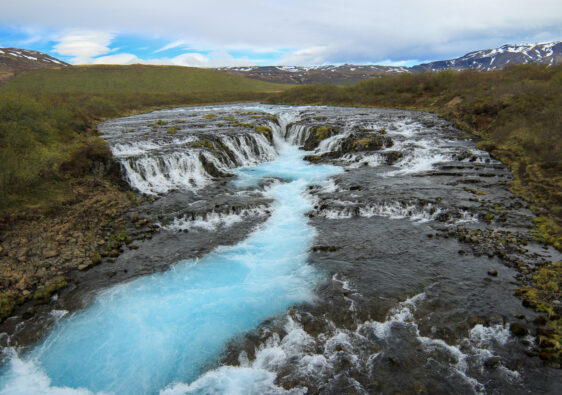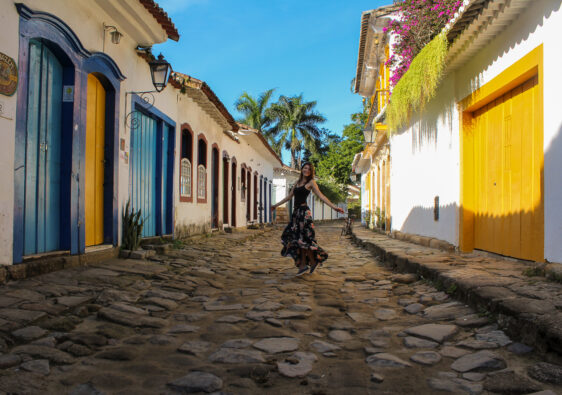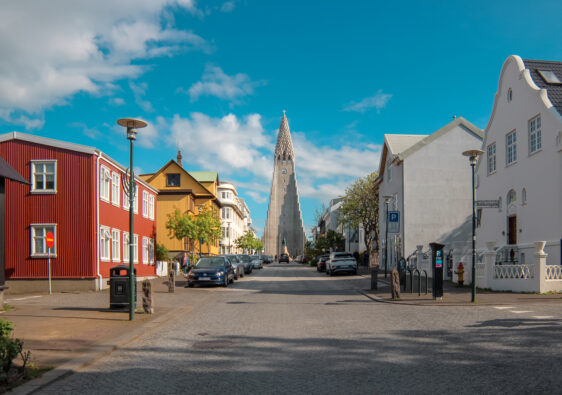Temperamental. I think that about sums up everything you need to know about planning a trip to the Drakensberg. I’ve never experienced four seasons in one day the way I did in those mountains. The Drakensberg is part of the Great Escarpment circling the large plateau also known as the kingdom of Lesotho. It’s also home to some of the most beautiful mountains I have ever had the pleasure of hiking.
We originally had booked this trip for Easter weekend 2020. Those plans were converted to travel vouchers the moment the pandemic hit. If you choose to do this trip during low season, I would book as you go. The reason I strongly discourage booking ahead is threefold. You can’t judge the quality of a lot of these places before you go. The weather can change quickly and your hiking plans will wash away. And you may find you want to stay in one place longer than expected. All of this happened to us.

We flew from Cape Town and landed in Durban at 9am on a Saturday and picked up our Toyota Corolla rental car. All roads are paved or at least not very thick with gravel, so no need to splurge on that 4×4, unless you want to drive up Sani Pass. We headed off first to our farthest point of the trip – Witsieshoek Mountain Lodge. We stopped on the way in Harrismith for groceries – don’t expect much from this town and be prepared for poorly stocked shops. From there, the lodge is another hour away through the town of Phuthaditjhaba.
The lodge itself is a joke if you consider how much you are coughing up for a basic room. It’s owned by the local village chief who clearly understands that upgrades aren’t needed if you have a superior location. The only reason you may want to consider staying at this overpriced lodge is if you plan to hike Tugela Falls in the morning – the hike start is down the gravel road. We stayed in the backpackers section, which has 6 rooms, some of which were far better than the others. If you book here, ask for room #2 – it faces the valley. The common room has a fridge, microwave, hotplates, mini oven, crockery and utensils.
When we arrived, there was a group of caveman-looking hikers sitting around the reception area drunkenly regaling their tales of hardcore adventure up to Tugela Falls that day. Don’t let people like that intimidate you – the hike is well within your abilities if you have hiked a 600m mountain before. You definitely shouldn’t miss Tugela Falls.
Tugela Falls Hike
To access the Tugela Falls hike, I would recommend paying the R160pp for the shuttle. Just make sure you have airtime so you can call the lodge to send a shuttle back for you when you’ve finished the hike. The 7km road to the Sentinel Car Park is paved in some places. There are unpaved sections with massive crevasses (as of Oct 2020) that many SUVs scrapped their underbellies on. Leave early in the morning because the drive alone is about 20 to 30 minutes. Also, the weather rapidly changes in the Drakensberg, particularly in the afternoon when heavy thunderstorms may roll in. Once at the car park, you can pay for your R95pp permits in cash. There are also toilets available which I highly recommend you use as there are no bushes for privacy along the way.
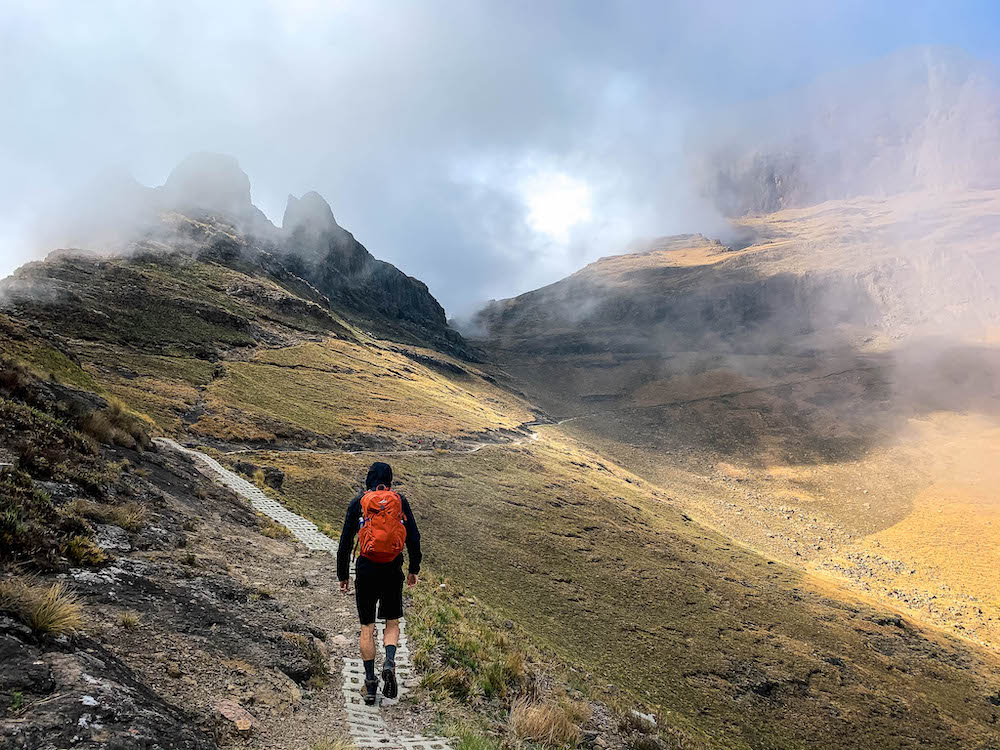
To follow the trail to the falls, I suggest you have the “Free State” and “KwaZulu-Natal” maps downloaded on Maps.me. The hike starts off relatively easy. You walk along cement blocks (placed to reduce erosion) for a good while at a gradual incline up and around the mountains towards the plateau. It’s technically easy but slow-going unless you are acclimatised to high elevations. At one point you’ll pass a rocky ravine going up to your left – this is the recommended route up to the falls. Ignore it. There’s a fallen sign in the gully mentioning something about the chain ladders are closed – ignore this too. Continue along the trail to the chain ladders.
If you’re not sure if you have a fear of heights, this is not the time to find out. You will be standing on a little ridge, with the mountain falling away steeply to either side of you. There are 30 metres of cliff-face now between you and the plateau connected by a two-section chain ladder. You have two options of ladders to get up. The first is more exposed to the wind and doesn’t have rings around the rungs to stabilise it against the cliff as you climb up, so it will sway dramatically in the wind. If it’s very windy, turn back. This ladder is terrifying. But it’s fully attached to hooks at the top. The second ladder is not. I opted for the second ladder as it was less exposed to the wind and had the rings around the rungs. It also, admittedly, had a ‘do not enter’ sign, but it felt stable enough at the time. In hindsight, after I saw the ladder was not linked in to the rock above, I’d opt for the first, fully secured ladder. Once at the top, Maps.Me becomes handy for navigating the rocky, unmarked area you’ll find yourself at. Simply keep climbing up the rocks until you see a riverbed stretching out below you. This is the Tugela River and, if you follow it, you will find the falls.
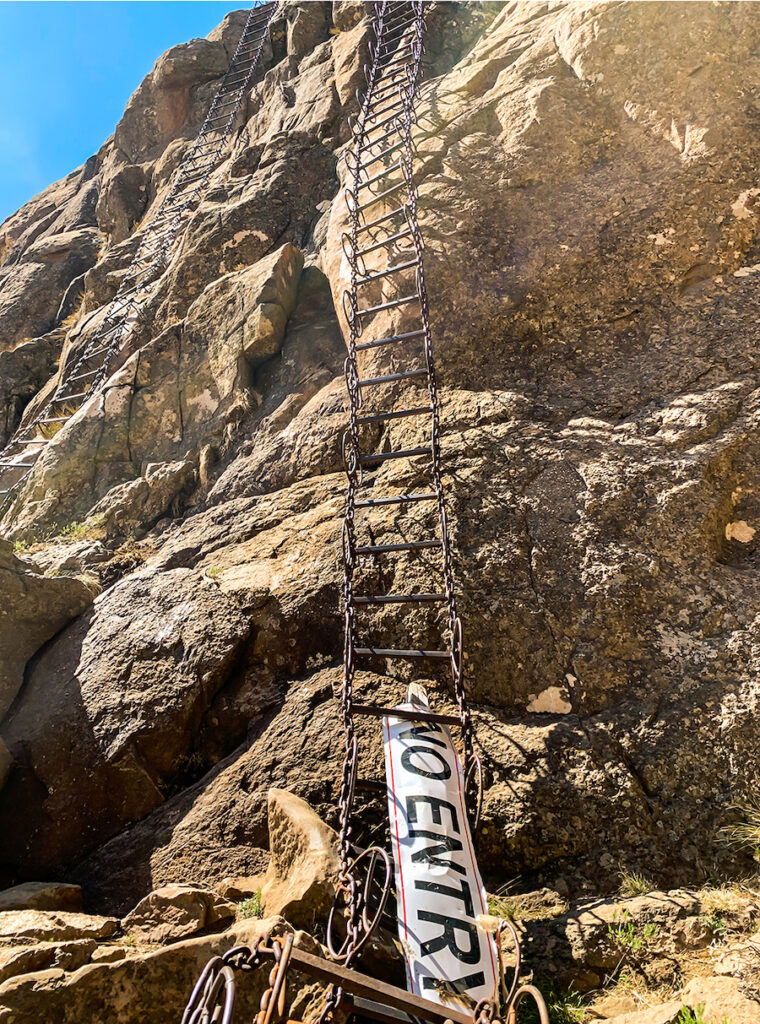
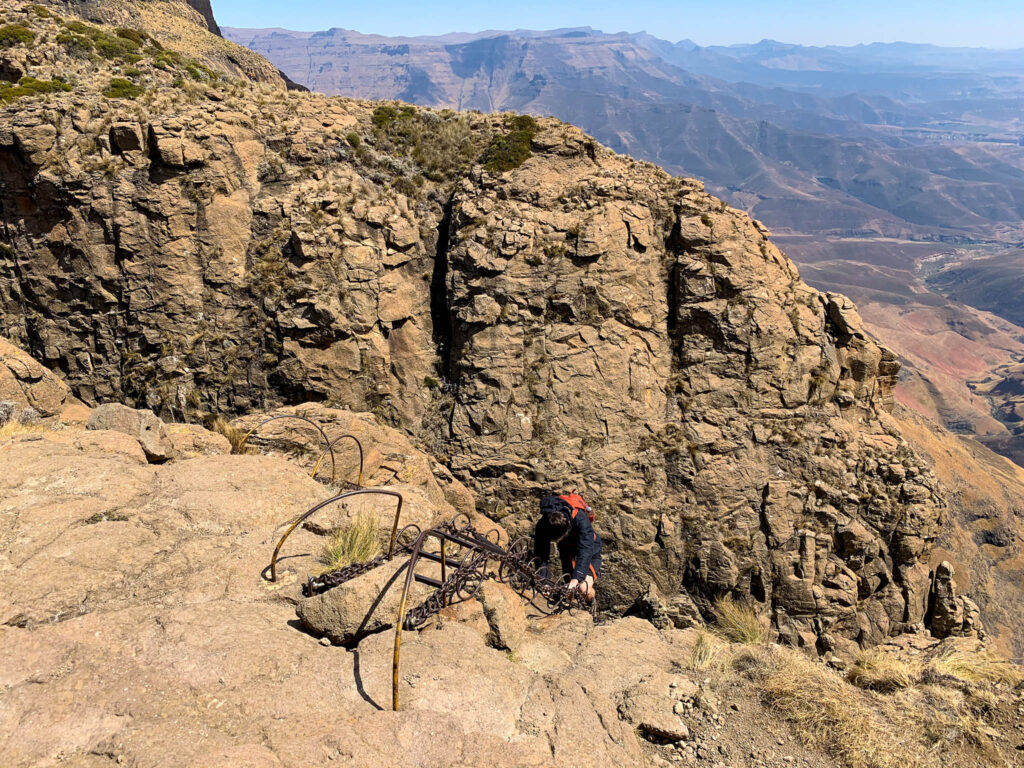
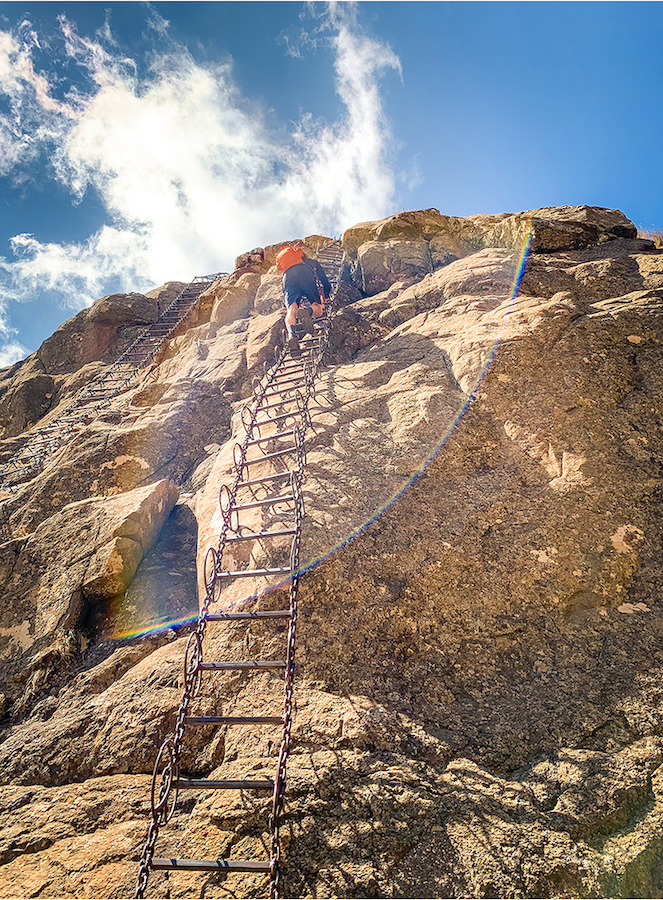
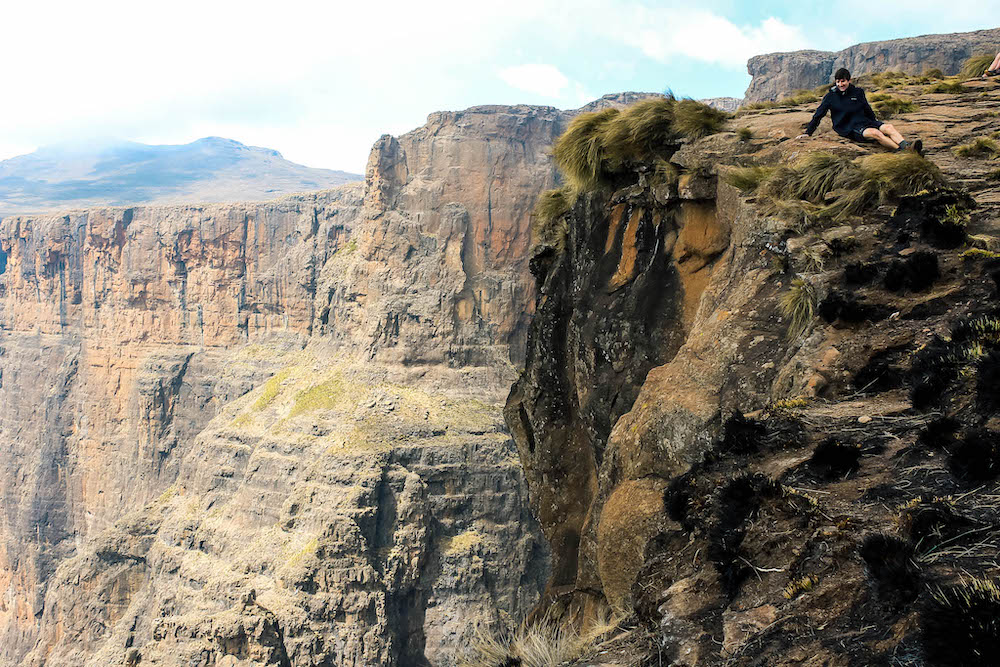
When we arrived it was cloudy, so we sat down on top of the world’s second highest waterfall to have lunch and wait for the clouds to lift. You can cautiously look over the ledge if you wish – it’s a 948m drop to the bottom so make sure your glasses, dentures, etc are secured. If you do this hike in the rainy summer months, you will experience something we did not – the actual waterfall. We visited at the tail-end of winter which is the dry season in the Drakensberg, so there wasn’t any water. So to answer any questions about when’s the best time to visit – it depends if you prefer cold, but dry hikes or warm, but wet hikes with the imminent threat of a thunderstorm cutting your day short. You can spend some hours up here, walking an hour to the Mont-Aux-Sources (the underwhelming source of the Tugela River) or walk over into Lesotho for a quick visit. There were only a few other hikers when we were there, and no sight of the infamous shepherds.
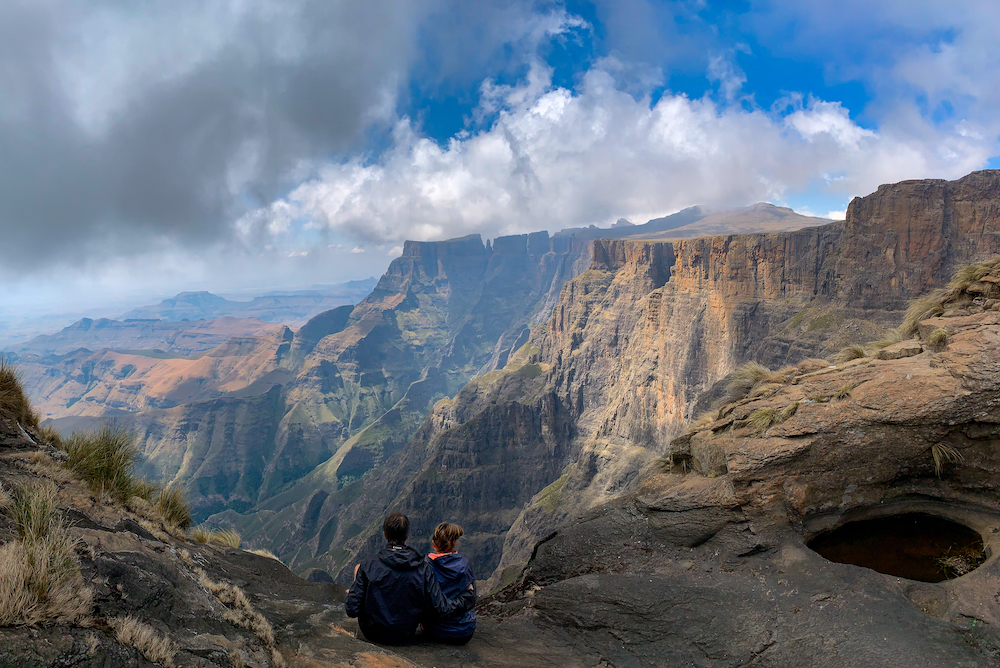
To return, I would go back the same way you came. Especially if the weather is picking up, this is the fastest way back. We, unfortunately listened to another overly-confident hiker’s advice, and took the shortest way back. When hiking, I’ve found that the shortest way back is usually the least desirable way. We followed a very faint trail up a mountain to the left of the falls using Maps.me (be mindful of the steep drops occasionally to your right). This led to some spectacular views of the Tugela Falls and the Amphitheatre before bringing us to the less spectacular ravine we had passed earlier on our way up. The ravine, admittedly is the shortest way down to the path to the car park. It’s also filled with a lot of loose rock and boulders that kept getting dislodged as we slid down. Personally, getting smushed by rock isn’t my thing, so I would have preferred returning via the ladders.
At this point, I would recommend against staying a second night at Witsieshoek as we did. You will have finished the hike by early afternoon with plenty of time to move on to either the Mahai or Golden Gate campsite.
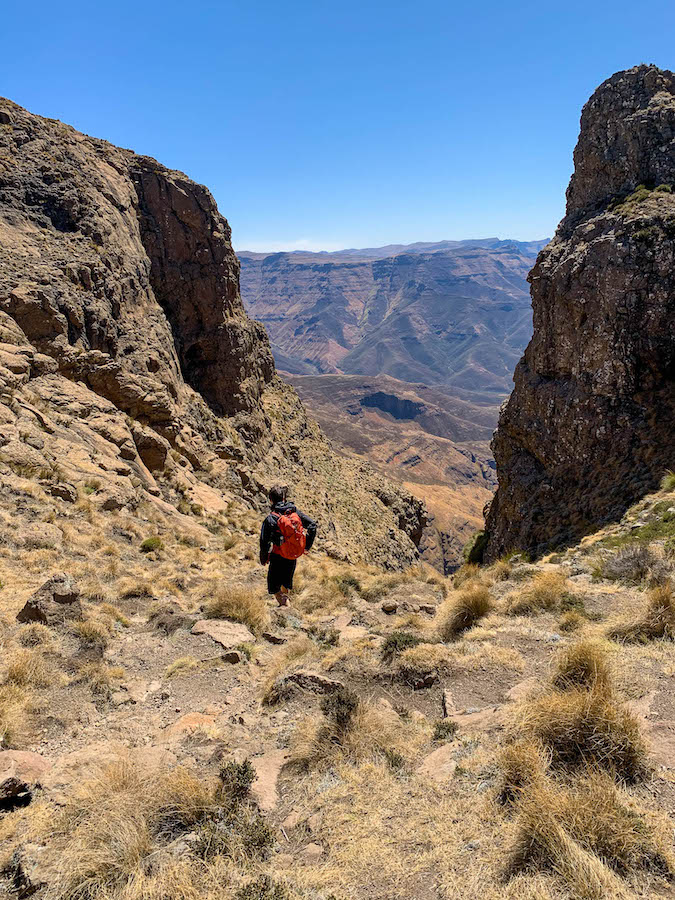
Royal Natal National Park
The Mahai campsite was, without a doubt, one of the nicest campsites I had ever been to. The campsite itself was fine – the abolutions were clean and there was hot water in the showers, the washing up stations have hot water boilers for your morning caffeine needs, and the entire campsite is fenced in from the baboon troops. The real benefit of camping there were the views and the half-day and full-day hiking options at your doorstep.
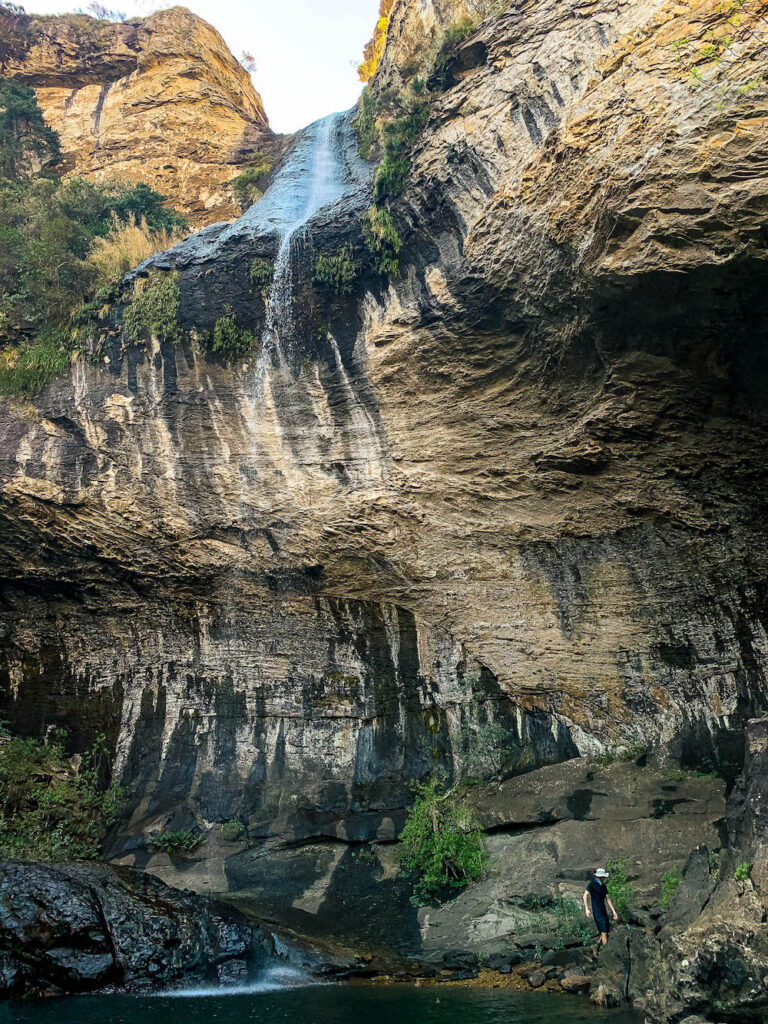

If you happen to be there on a hot day, the Cascades are beautiful natural pools and low falls ideal for swimming and lounging. Otherwise, from there you can hike out to Gudu Falls, Fairy Glen, the Crack, etc. You can find all of these via Maps.me. All of these hikes require a permit as part of the Royal Natal National Park, but the fees are waived if you have a Wild Card. We spent our first half-day venturing out to the base of Gudu Falls via the mushroom-shaped Lookout Rock. Unfortunately, it turned out to be a there-and-back route as we couldn’t find a safe way to link up with Plowman’s Kop up above. Other hikes in the area include Policeman’s Helmet, which we didn’t do but we saw along Tugela Gorge. Should you hike it, you will be rewarded with a fantastic view of the Amphitheatre.
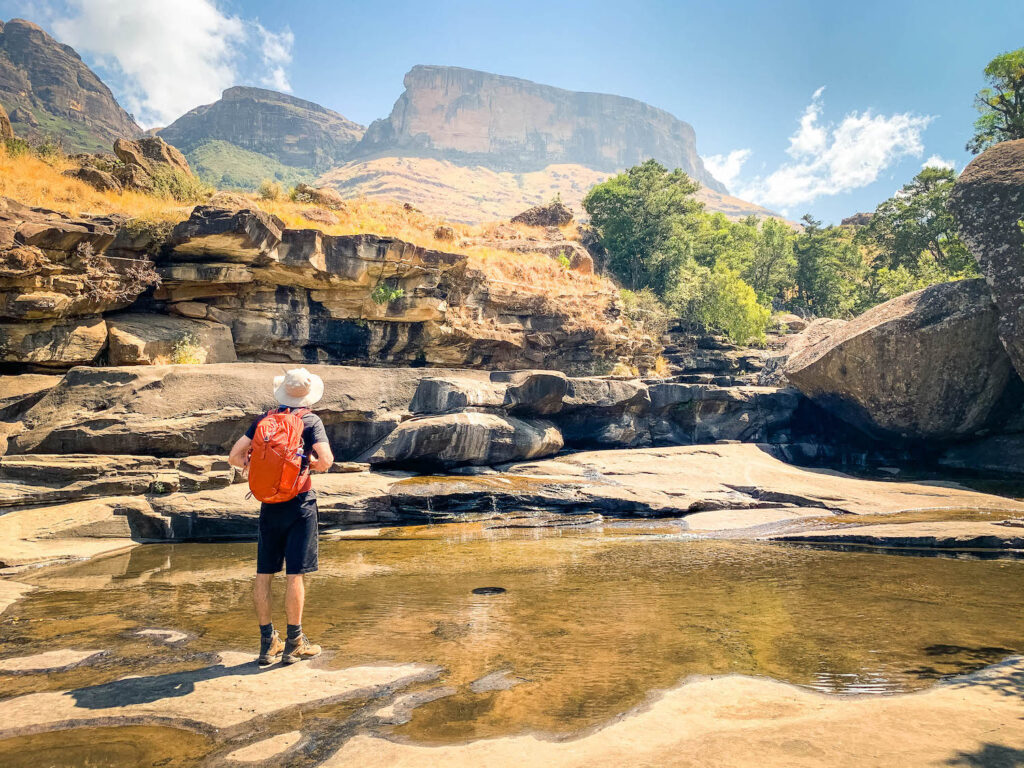
A short drive down the road will bring you to the start of the 17km Tugela Gorge hike. I found this hike to be pretty anticlimactic and would skip it if you are short on time. Essentially, you follow a pretty flat trail to the start of a boulder-strewn gorge. If you do opt for this hike, steer clear of the gorge’s walls – we dodged several rock falls. Rock hop until you get to a set of narrow cracks where you will need to swim or wade through icy water, depending on how full the river is. Just before these cracks, there’s a ladder (again with a ‘do not enter’ sign) that you can climb up and follow an underused path that maybe brings you to the base of the falls. I’m not entirely sure because I didn’t feel like bushwhacking after 500m.
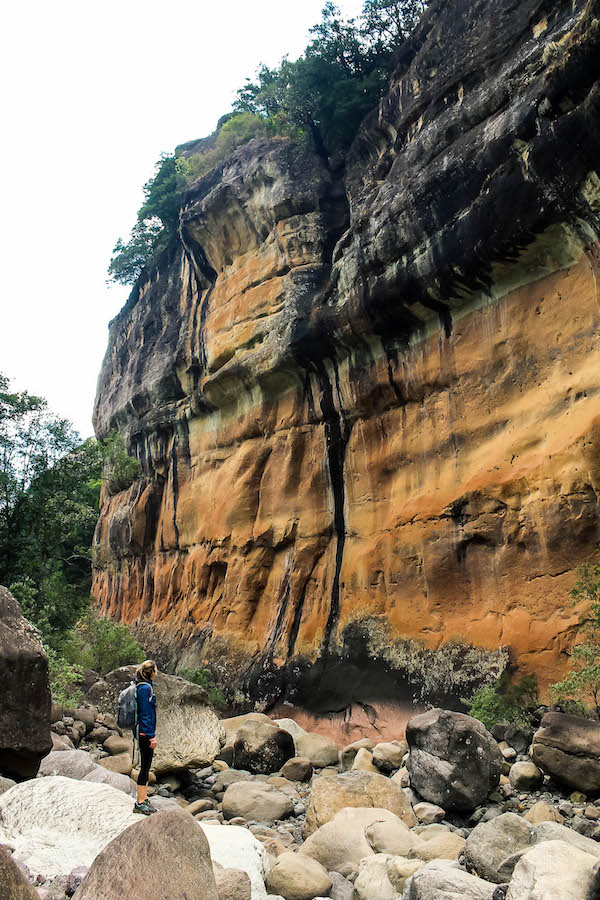
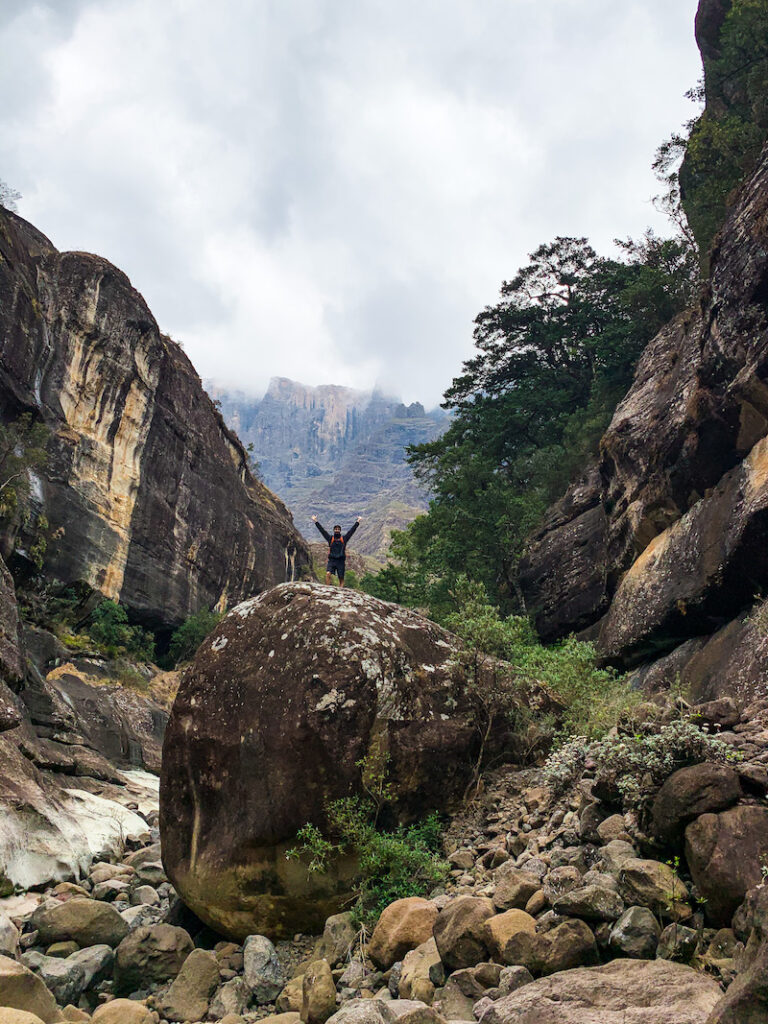
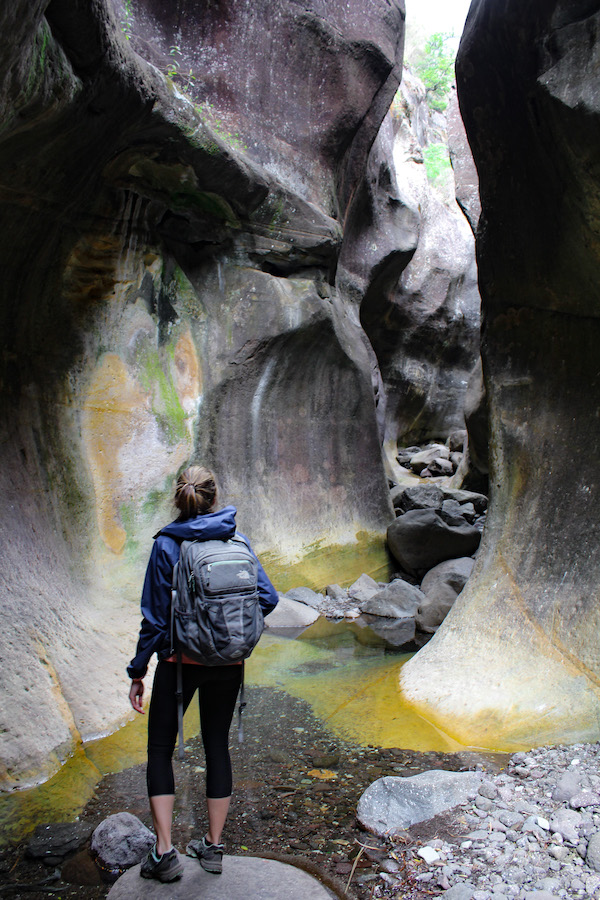
Rather than wasting a day on the over-hyped Tugela Gorge hike, spend your time exploring the trails leading out of the campsite, and if you like horseback riding, go on a trail ride. The stables by Rugged Glen offer different riding options from as short as one hour to as long as six. We opted for the six-hour ride for R550 per person (mainly because I couldn’t get over how cheap this was compared to one hour of riding lessons in the US so I felt obliged to take the deal). The ride was advertised as casual with two stops at points of interest along the way. Now, maybe it was the lack of trail use because of the pandemic or maybe it’s just always like this, but the trail we followed wasn’t really a trail. We rode with two men who regularly dismounted to build a bridge out of stones or fell trees with their machetes. I also wouldn’t do this trail ride unless you have experience and a strong gut. I say this because you will need a lot of strength and courage to get your horse to go up steep mountainsides, jump over streams, and rein them in as they try to dart back home. To illustrate, at one point high in the mountains, my horse decided it didn’t want to continue going up and began backing off the trail towards a cliff. My thighs were so swollen from edging the horse forwards back to the trail that I couldn’t get a pair of jeans on for the following week. Despite questionable moments, the six-hour ride is completely worth it – where else in the world can you go riding on this kind of mountainous terrain with views like the Drakensberg?
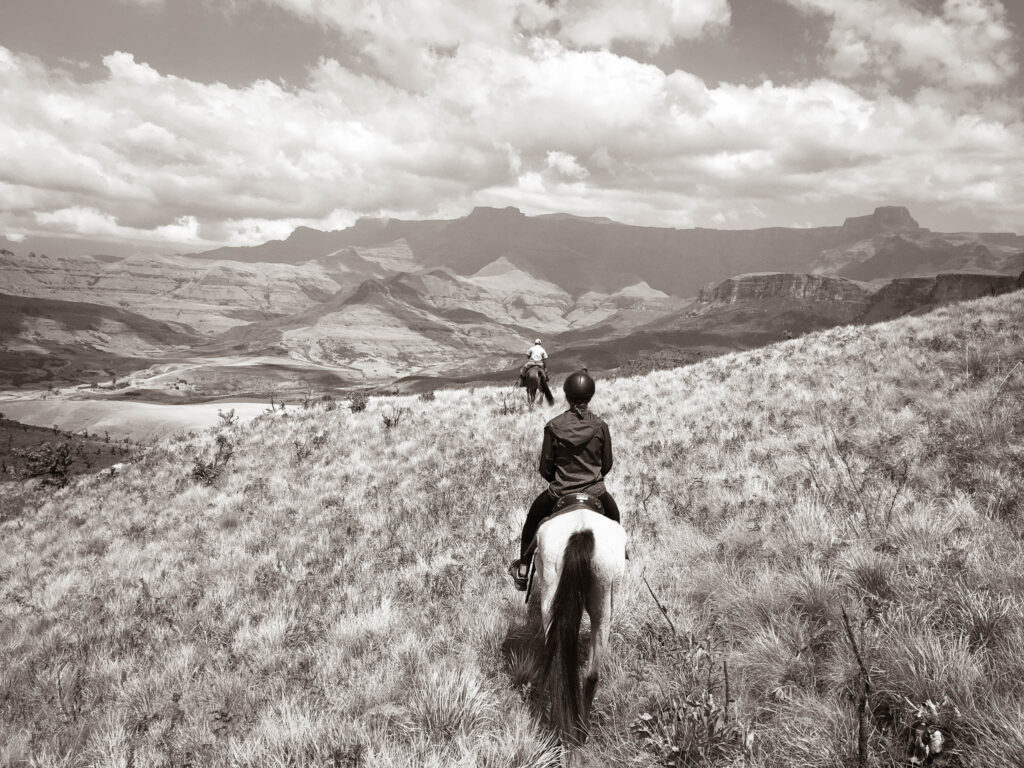

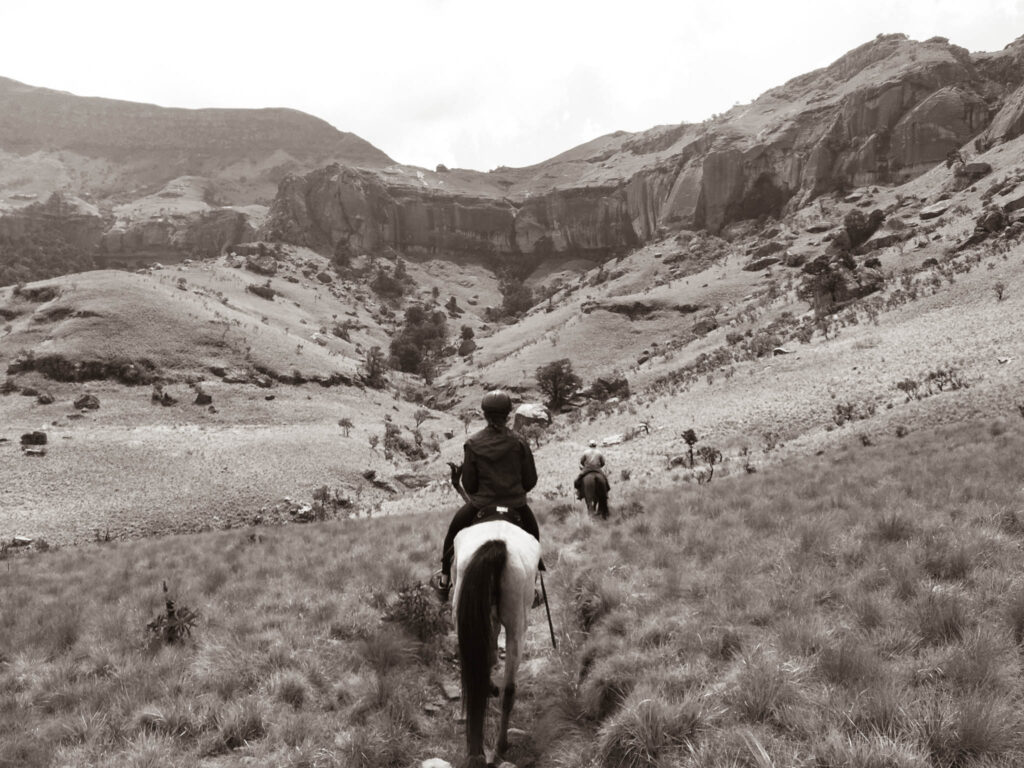
The Slow Return to Durban
The weather turned for the worse as storm clouds gathered by 7am on our third morning in Royal Natal. We had originally planned to camp the next two nights at Monks Cowl (our preferred stop was Injisuthi but the area was closed due to a fire a week before). We packed up our camping gear before the rain started and, since we never seemed to leave the clouds, decided to make a change of plans and checked into a cottage near Champagne Castle instead. Given the state of our legs after three days of hiking and a day of riding, this ended up being a fantastic decision. We were able to carefully repack all of our camping gear and relax with a braai complete with halloumi from the nearby Macedonia Cheese Shop. Despite the persistent rain and rumbling thunder we managed to squeeze two short (2h) hikes in to waterfalls in Monks Cowl. Had the weather been better, we could see some longer hikes that wound through the mountains we would have been eager to try out.
When you head back to Durban, skip the N3 from Mooi River to Howick and take the R103 instead. You’ll pass farm stalls, quirky shops and nicer scenery than you would have along the highway. Stop by the Waffle Inn if you can – the waffles are good and the owners have some fun stories, the husband was on the Nationwide plane whose engine fell off during take-off.

If you find you need to spend time in Durban, stay in Umhlanga in North Durban, preferably on the ocean side of the M4 so you can walk along the promenade and visit the beaches. We had a rainy day to kill in Durban, so we visited the uShaka Marine World for a few hours which is probably more entertaining for kids, but we enjoyed the information about ocean conservation. We also tried some bunny chow at Hollywood Bet – you know it’s authentic when they don’t provide utensils. Bunny chow, for those who aren’t familiar, is a hollowed-out loaf of white bread filled with curry. We ordered the mild curry, but even that was so spicy I had to see my doctor for medications to fix my stomach lining when we got back to Cape Town.
Planning Tips
If you have only 4-5 days, I would recommend basing yourself in one part of the Drakensberg and doing hikes from there. Royal Natal is ideal given the range of hikes on offer. If you choose to visit, you can fly to either Johannesburg or Durban and drive around the same time to get here. Though, the drive from Durban is the more scenic route of the two. If you are looking for less driving, because you are constricted to 200km a day with your rental car or such, then I would go to Injisuthi in Giants Castle. For those that enjoy lower lying hills, Highmoor is your place. As for those who like going off the beaten path and have a high-risk tolerance, then I hear Mweni is the spot for you. Just be sure to inform yourself about safe overnighting spots and which routes are safest to walk given the drug trafficking in the area. If you have a full week free, then I would split my time between two areas, like Royal Natal and Injisuthi.
Packing Essentials
Regardless of the time of the year you go, you will want comfortable camping gear. If you are going in the dry season, April to October, pack a warm sleeping bag. Nights can get extremely cold and our sleeping bags, designed for 10°C, didn’t cut it. Pack warm clothes for hiking. I accidentally grabbed my calf-length yoga pants instead of full-length underarmour which was an issue on top of Tugela Falls where puddles of water were frozen solid. A rain jacket is a must as well. In the dry season, it can double as a windbreaker. I think proper hiking shoes goes without saying. We packed a space blanket just in case we got caught on the trails and would have to weather out the storm until we could safely resume the hike. A small cooler box is useful for keeping perishables fresh.
To avoid getting lost on the trails, download Maps.Me offline maps and potentially also AllTrails. Bring a battery pack. I checked out some hiking guidebooks from the local library which were useful as well – “Walking in the Drakensberg” was good.
